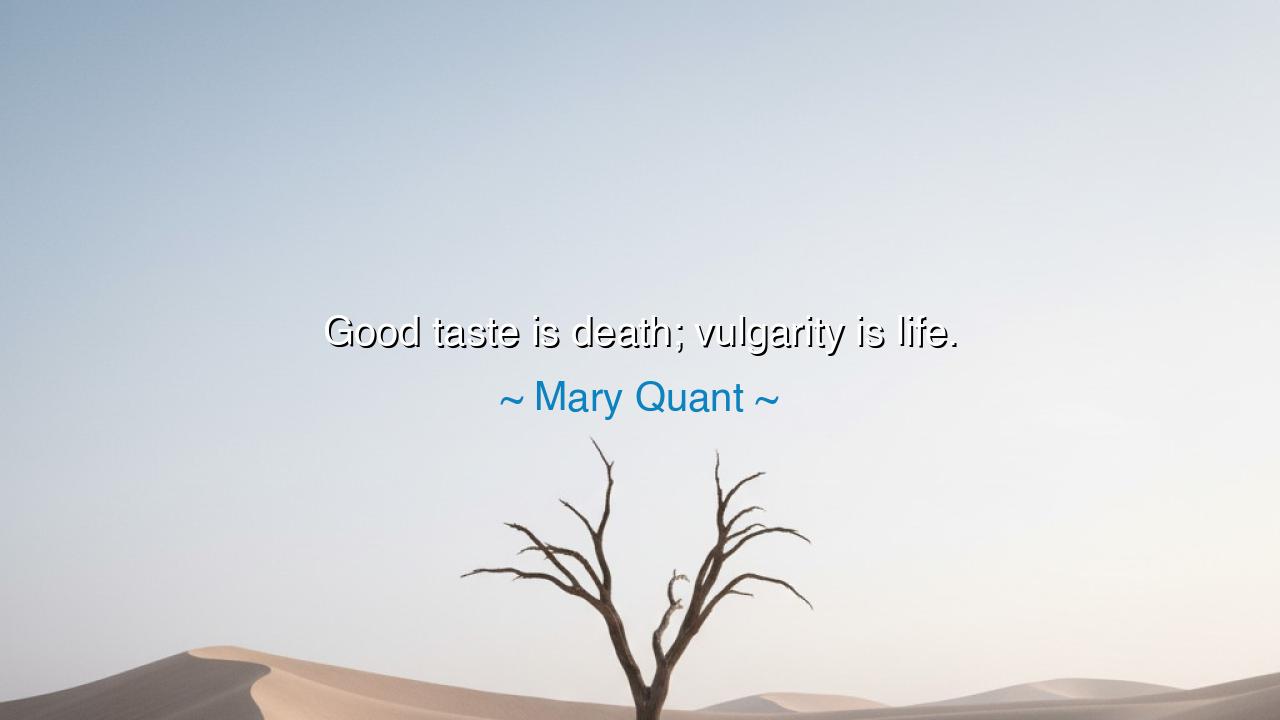
Good taste is death; vulgarity is life.






“Good taste is death; vulgarity is life.”
Thus spoke Mary Quant, the rebellious high priestess of fashion, who ignited the spirit of youth in the 1960s and clothed a generation in freedom. In these few shocking words, she broke the chains of convention and declared a revolution—not merely of style, but of the soul. To her, “good taste” was not refinement, but restraint—the lifeless obedience to old rules crafted by others. “Vulgarity,” in her defiant tongue, was not shameful, but vitality—the raw, unapologetic expression of individuality. She meant that to live fully, one must dare to offend, to surprise, to breathe color into the grey conformity of the world.
The origin of this thought comes from Quant’s rebellion against the rigid traditions of postwar Britain. In an age that worshipped propriety and “good taste,” she unveiled the miniskirt, the bold color, the playful cut—and through them, she freed women from the armor of decorum. Her creations were called vulgar, but in that vulgarity there was life—movement, laughter, desire, rebellion. She saw that “good taste” too often means fear: the fear of being judged, the fear of standing apart. But life—true life—thrives in boldness, in daring, in the courage to create beauty unapproved by the crowd.
To understand this wisdom, recall the great cycle of art and civilization. Every era that has burned with brilliance began with vulgarity. When Impressionism was born, critics called it crude. When jazz rose, it was said to be the devil’s music. When modern poetry emerged, it was condemned as nonsense. Yet all these “vulgar” things became the lifeblood of culture, the sound of humanity renewing itself. Good taste preserves what is dying; vulgarity gives birth to what is new. Quant knew this truth: that every creative spirit must choose between safety and vitality—between embalmed beauty and the fierce pulse of life.
Consider Vincent van Gogh, that tortured servant of color. In his time, he was mocked as vulgar, his thick strokes and violent yellows called mad. But Van Gogh painted not for approval—he painted what he felt. His vulgarity was life itself: unfiltered, radiant, and tragic. He saw the world not through the eyes of “taste,” but through the eyes of truth. And though he died poor and scorned, his art outlived empires. What the world once condemned as vulgar became the very definition of genius. So it is with all creators who choose vitality over conformity—they die misunderstood but are resurrected by time.
Quant’s statement, then, is not a hymn to vulgarity for its own sake, but a call to authenticity. She reminds us that the pursuit of perfection can kill the spirit, and that imperfection is divine because it breathes. To live according to “good taste” is to live within walls; to live with “vulgarity” is to open the gates and run into the wind. The life-force—creative, sensual, daring—cannot survive under the rules of polite society. It must break form, shout color, and move as it will. For what is life but the art of daring to be fully, unashamedly oneself?
And yet, there is wisdom too in balance. Quant did not mean that vulgarity should be chaos or cruelty, but that it should be honest. The vulgarity she praised was the courage to feel and express—to laugh too loudly, to wear too brightly, to love too fiercely. It is the defiance of the soul against stagnation. When humanity loses this wildness, it grows cold, obedient, and dead. The artist, the dreamer, the innovator—all must keep this flame alive, even when the world calls it indecent.
So, O listener, take this lesson: beware of “good taste” when it becomes a cage. Do not kill your colors for fear of judgment. Let your art, your voice, your choices carry the mark of your spirit—even if others call it vulgar. Live vividly, create boldly, speak truth even when it trembles. For the world is not saved by those who follow the rules, but by those who break them with love and fire. Remember this: “Good taste is death; vulgarity is life.” Choose life—choose the beautiful disorder of authenticity—and you will never walk among the dead.






AAdministratorAdministrator
Welcome, honored guests. Please leave a comment, we will respond soon